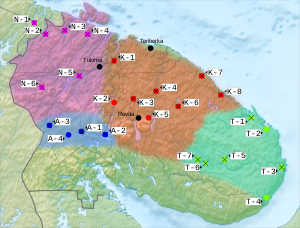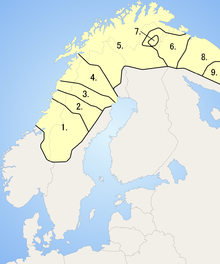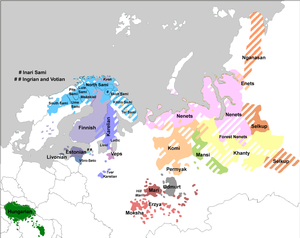lingvo.wikisort.org - Language
Ter Sámi is the easternmost of the Sámi languages. It was traditionally spoken in the northeastern part of the Kola Peninsula, but now it is an extinct language; in 2004, only ten speakers were left. By 2010, the number of speakers had decreased to two.[1] In 2020, they were presumed dead or uncontactable.[citation needed] Other estimates counted about 30 Ter Sámi speakers in Murmansk oblast, as well as in St. Petersburg, in 2007. The mean age of the youngest Ter Sámi speakers at that time was 50.[3]

| Ter Sámi | |
|---|---|
| saa´mekiil / са̄мькӣлл | |
| Native to | Russia |
Native speakers | 2 (2010)[1] |
Language family | |
Writing system | Latin script (historical), Cyrillic script (current) [2] |
| Language codes | |
| ISO 639-3 | sjt |
| Glottolog | ters1235 |
| ELP | Ter Saami |
 Ter Sámi is number 9 on the map. | |
 Ter Sámi is classified as Critically Endangered by the UNESCO Atlas of the World's Languages in Danger (2010) | |
History

Photo taken in 2006.
In the end of the 19th century, there were six Ter Sámi villages in the eastern part of the Kola Peninsula, with a total population of approximately 450. In 2004, there were approximately 100 ethnic Ter Sámi of whom two elderly persons speak the language; the rest have shifted their language to Russian.[4]
The rapid decline in the number of speakers was caused by Soviet collectivisation, during which its use was prohibited in schools and homes[citation needed] in the 1930s, and the largest Ter Sámi village, Yokanga, was declared "perspectiveless" and its inhabitants were forced to move to the Gremikha military base.[4]
Phonology
Consonants
| Labial | Alveolar | Post- alveolar |
Palatal | Velar | Glottal | |
|---|---|---|---|---|---|---|
| Plosive | p b | t d | k ɡ | |||
| Affricate | t͡s d͡z | t͡ʃ d͡ʒ | ||||
| Fricative | f v | s z | ʃ ʒ | x | h | |
| Nasal | m | n̥ n | ŋ | |||
| Approximant (Lateral) |
j | |||||
| l̥ l | ||||||
| Trill | r̥ r |
- All consonants except for /j/ may be palatalized [ʲ].
- Consonants /t, d/ can also sound as half-palatalized.
Vowels
| Front | Central | Back | ||||
|---|---|---|---|---|---|---|
| short | long | short | long | short | long | |
| Close | i | iː | ɨ | ɨː | u | uː |
| Mid | ɛ | o | ||||
| Open | a | aː | ɔ | |||
- After palatalized consonants, /ɛ/ is realized as [e].[5]
Documentation
There are no educational materials or facilities in Ter Sámi, and the language has no standardized orthography. The language is incompletely studied and documented, though text specimens and audio recordings as well as dictionaries for linguistic purposes exist.[6][7]
Writing system
A spelling system for Ter Sámi using the Latin alphabet and based on Skolt Sámi was developed in the 1930s. After the Second World War, this was replaced by a system using the Cyrillic alphabet, and based on Kildin Sámi.[8] This system was used by the Sámi poet Oktyabrina Voronova.[9]
Example of words in Ter Sámi
| Ter Sámi | English gloss |
|---|---|
| выэййвэ | head |
| ныкчым | tongue |
| кидт | hand |
| лоннҍт | bird |
| чадце | water |
| ке̄ддҍкэ | stone |
| аббьрэ | rain |
| толл | fire |
Grammar[11]
Ter saami has 8 cases, Nominative, Genitive, Accusative, Essive, Inessive-Lative, Dative-Illative, Abessive and Comitative.
| case | singular | plural |
|---|---|---|
| NOM | - | change of the main part of word |
| GEN | change of the main part of word | change of the main part of word |
| ACC | change of the main part of word | t |
| ESS | n | n |
| INE | s't | n |
| DAT | a, i | t |
| ABE | ta | ta |
| COM | n | k'em, g'em |
Examples of the Genitive
(in the UPA)
abre' paл = raining cloud
pɛci̮ pal'čemi̮š = slaughter of deer
taja oлmi̮j = German inhabitant
tara parnɛ = Russian boys
Plurals
In the Nominative case the base word changes when a plural is made.
| Word | Meaning | Plural | Meaning |
|---|---|---|---|
| mi̮rr | forest | mi̮r | forests |
| k'iлл | language | k'iл | languages |
| šiɛn'n' | swamp | šiɛn' | swamps |
| tast | star | taast | stars |
The word "ku", meaning: who, which in the cases.
| Case | Singular | Plural |
|---|---|---|
| Nominative | ku | kogg |
| Genetive | konn | kojt |
| Accusative | konn | kojt |
| Essive | kon'n'in | kojn |
| Inessive | kon'n'es't | kojn |
| Dative | kon'n'i | kojt |
| Abessive | konta | kojta |
| Cominative | kon'in | kojgujm |
Notes
- Nilsen, Thomas (2010-02-19). "Sami languages disappears". Barent's Observer. Retrieved 2022-06-04.
- "Ter Sámi alphabet, pronunciation and language". Omniglot.com. Retrieved 27 November 2017.
- Rießler, Michael; Wilbur, Joshua (2007). "Documenting the Endangered Kola Saami Languages". In Bull Tove; Kusmenko, Jurij; Rießler, Michael (eds.). Språk og språkforhold i Sápmi [Language and Language Conditions in Sápmi]. Berlin, Germany: Nordeuropa-Institut. p. 40. ISBN 978-3-932406-26-3.
- Tiuraniemi Olli: "Anatoli Zaharov on maapallon ainoa turjansaamea puhuva mies", Kide 6 / 2004.
- Tereškin, Sergej N. (2002). Jokan'gskij dialekt Saamskogo Jazyka. Sankt Petersburg: Rossijskij Gosudarstvennyj pedagogičeskij Universitet imeni.
- Itkonen T. I.: "Koltan- ja kuolanlapin sanakirja", Helsinki: Société Finno-Ougrienne, 1958.
- Itkonen T. I.: "Koltan- ja kuolanlappalaisia satuja", 1931.Memoires de la Société Finno-Ougrienne 60
- "Ter Sami alphabet, pronunciation and language". Omniglot.com. Retrieved 16 February 2018.
- Rießler, Michael (2018). "Kola Sámi literature (Kildin Sámi, Ter Sámi, Akkala Sámi)". In: "Čálli giehta olla guhkás" A writing hand reaches further ({S}ámi proverb) Johanna Domokos (ed.). Helsinki: Yhdenvertaisen kulttuurin puolesta ry, pp. 73–78.
- "Tersamisk - Allkunne". www.allkunne.no (in Norwegian). Retrieved 2021-01-24.
- Tereškin, Sergej (2002). . Йоганьгский диалект саамского языка. Saint Petersburg.
External links
 Media related to Ter Sami language at Wikimedia Commons
Media related to Ter Sami language at Wikimedia Commons- Ter saami dictionary
- Die Struktur der Nominalphrase im Tersaamischen (in German)
- Koltan- ja kuolanlapin sanakirja (dictionary in German, contains Ter Saami)
- Koltan- ja kuolanlappalaisia satuja (texts in Kola Saami languages, includes Ter Saami)
На других языках
[de] Tersamische Sprache
Tersamisch ist die östlichste aller samischen Sprachen und gehört somit zur uralischen Sprachfamilie. Heute gibt es vielleicht noch 2 aktive Tersamischsprecher auf der Kola-Halbinsel im Nordosten Russlands. Etwa 20 Personen haben Sprachkenntnisse auf verschiedenen Niveaus. Die Sprache ist nicht nur vom Aussterben bedroht, sondern auch relativ schlecht dokumentiert und beschrieben.- [en] Ter Sámi
[fr] Same de Ter
Le same de Ter est une langue same parlée par les Samis du nord-est de la péninsule de Kola, en Russie, notamment dans le raïon de Ter. C'est une langue presque disparue : en 2004, dix personnes parlaient le same de Ter, et en 2010 seulement deux[1].[it] Lingua sami di Ter
La lingua sami di Ter è una lingua sami parlata in Russia.[ru] Йоканьгско-саамский язык
Йоканьгско-саамский язык, или терско-саамский язык, — самый восточный из саамских языков. Распространён в северо-восточной части Кольского полуострова.Другой контент может иметь иную лицензию. Перед использованием материалов сайта WikiSort.org внимательно изучите правила лицензирования конкретных элементов наполнения сайта.
WikiSort.org - проект по пересортировке и дополнению контента Википедии
